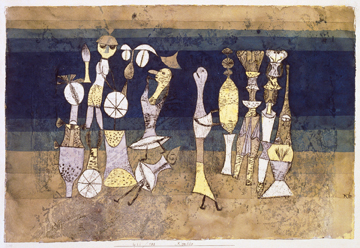Art Essay: The Child Within – Part 1 (Art)
By Ina Cole
ART TIMES Winter 2013
 Paul Klee, “Comedy” (1921), watercolour and oil on paper, 305 x 454 mm, (picture credit: Tate) |
In 1830 the German painter Caspar David Friedrich expressed that, ‘The only true source of art is our heart, the language of a pure childlike spirit’ (Fineberg 1997). As the cultivation of the naïve began to gain interest, a concept prevailed that children were less civilized and therefore closer to the real meaning of existence. Their primal mark making is one of the first signs of ordered communication, and it was believed that through this innocence of expression the child was the commentator of the truth and that their scribbling would naturally have a perfect unity of composition. However, it was the Swiss educator and illustrator, Rodolphe Töpffer, who became one of the first to seriously study the art of children. His research, published in 1848, was important in that it praised the expressive genius in their work and emphasized the centrality of ideas over technical execution. This shift in ideology was significant in that it encouraged personal expression undiluted by conventional forms, which in turn offered a return to a more primordial and instinctive state of being.
As the rise of empirical observation and spontaneous discovery overtook a reverence for traditional formal values, a fundamental change occurred which was seen to offer a kind of purification for Western culture’s materialism, also making possible the concept of primitivism at the turn of the twentieth-century. This notion preoccupied not only artists, but biologists, social theorists and psychologists. Parallels were often drawn between the savage and the child and this also became a criterion against which levels of primitivism were measured in anthropological thought. The child was at the heart of these theories, their observed stages of physical and psychological development used as a gauge to measure comparative levels of cultural complexity in groups ranging from the presumed ‘savages’ of Africa, America and Oceania, to Europe’s peasant population. When the same argument was later extended to early twentieth-century models of disease, the concept of the primitive came to include the mentally ill and criminals, whose so-called conditions were commonly understood as degenerative; a kind of twisted return to primitive states.
By retreating from accepted reason artists thought they could gain access to the very sources of creativity itself, which they believed was exemplified in its most authentic and liberated form in the minds of children, the insane and tribal cultures. However, just as European artists received a needed impulse from African carvings about whose meaning and function they actually knew little, so the strong influence of children’s drawings relied on interpretations that did not directly correspond with the states of mind producing those unassuming pictures. The child responds to its environment by making images of what it perceives and the picture, therefore, does not merely imitate the model but helps to clarify the structure of what is seen. Children’s drawings appealed to the adult artist not because they are so different, but because they actually derive from the same source; that is a way of understanding the human condition by means of significant form.
In the early twentieth-century belief in the creative instincts of children was fairly universal amongst modern artists. Wassily Kandinsky, Gabriele Münter, Paul Klee, Mikhail Larionov and the CoBrA artists all collected the work of children and in some instances took quite specific cues from them. The attraction lay in the way that children observe with an acuteness that derives from the fact that everything before their eyes is a new experience. In a diary entry of 1901, Klee reflected on the prevailing mood of the time through his observation of a singing child: ‘I have seen many artistic achievements, but never one so primeval…talent anticipates things through intuition which it could experience only later, having the advantage that primitive feelings are the strongest. The future slumbers in human beings and needs only to be awakened’ (Klee 1965).
However, picture making does not rely solely on what the eye sees at the moment the image is produced, but a synthesis of observations already stored in the brain, and here lies the true difference between the child and the adult. It is impossible to recapture the original expressive effects of child art, as this would have been produced in an entirely different context. Such borrowings, therefore, rather than being an attempt at imitation were transformed and assimilated into the artists’ own style. Indeed, many of the formal qualities shared by modern and primitive art can be linked to the twentieth-century’s interest in conceptual modes of imagining. The use of reductive signs for direct illustration offered an opportunity to explore analogies of a type long familiar to tribal artists. In much the same way the work of children is also conceptual rather than imitative, and through its resemblance to primitive art could be seen to recapitulate the artistic evolution of the human race, offering a desired new beginning for artistic development.
Kandinsky: From Blaue Reiter to the Bauhaus, Neue Galerie, New York to 10 February 2014; Paul Klee, Tate Modern, London to 9 March 2014; Paul Klee: Life and Work, Zentrum Paul Klee, Bern, to 30 March 2014; Spirit of CoBrA, The Museum of Art, Fort Lauderdale to 18 May 2014.
